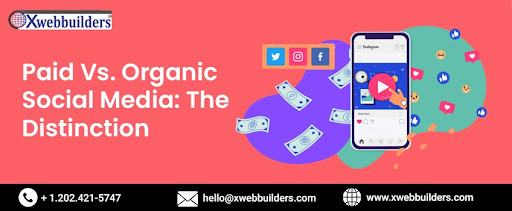
September 01, 2025

In today's digital age, social media has become integral to our daily lives. From connecting with friends and family to promoting businesses and brands, social media platforms have transformed communication and interaction. However, two main approaches emerge when utilizing social media for marketing and outreach: paid and organic social media. Understanding the distinction between these two strategies is crucial for an SEO agency to contribute to businesses and individuals looking to maximize their online presence and achieve their goals.
Paid social media refers to investing financial resources to promote content or advertisements on various social media platforms. This strategy involves using paid advertising tools from platforms like Facebook, Instagram, Twitter, and LinkedIn to reach a specific target audience. Here are some key elements of paid social media:
1) Budget Allocation: Paid social media requires setting aside a budget to fund advertising campaigns. This budget can vary widely depending on the goals, audience size, and platform used.
2) Ad Formats: Paid social media offers a range of ad formats, including sponsored posts, display ads, video ads, carousel ads, and more. These formats allow businesses to create visually engaging and compelling content to capture the audience's attention.
3) Targeting Options: Paid social media provides advanced targeting options, enabling advertisers to define their audience based on demographics, interests, behavior, and more. This precision targeting helps ensure that the content reaches the right people.
4) Metrics and Analytics: One of the advantages of paid social media is the ability to track and measure the performance of campaigns in real time. Metrics like click-through rate (CTR), conversion rate, engagement rate, and return on ad spend (ROAS) provide valuable insights into campaign effectiveness.
5) Immediate Results: Paid social media can deliver quick results as ads are immediately visible to the intended audience once the campaign is launched. This immediate impact can be especially beneficial for time-sensitive promotions or product launches, instilling a sense of optimism about the potential of paid social media for your business.
Organic social media, on the other hand, involves creating and sharing content on social media platforms without paying for promotion. It relies on building an engaged and loyal audience through consistent, high-quality posts. Here are some key elements of organic social media:
1) Content Creation: Organic social media requires businesses and individuals to regularly create valuable, relevant, and engaging content. This content can include posts, images, videos, stories, and more.
2) Audience Engagement: Building and nurturing a community of followers is central to organic social media. Engaging with followers through comments, likes, shares, and direct messages fosters a sense of connection and loyalty.
3) Algorithm Dependence: Organic reach on social media platforms is influenced by algorithms that determine the visibility of content to followers. These algorithms consider factors like engagement, relevance, and timing. Understanding these algorithms can help you tailor your content to increase its visibility.
4) Long-term Strategy: Organic social media often requires a long-term commitment to building a presence and growing a following gradually. While success may take time, the patient and committed approach to organic social media can lead to a dedicated and loyal audience over time, instilling a sense of the long-term benefits of this strategy.
5) Cost-Effective: Organic social media does not require a dedicated advertising budget, making it a cost-effective option for businesses with limited resources.
Now that we have defined paid and organic social media, let's explore the key distinctions between the two approaches:
1) Cost: The cost is the most apparent difference between paid and organic social media. Paid social media requires a financial investment, while organic social media relies on the time and effort invested in content creation and engagement.
2) Speed of Results: Paid social media typically yields faster results as ads are immediately visible to the target audience. On the other hand, organic social media takes time to build an audience and see significant results.
3) Control Over Reach: With paid social media, advertisers have more control over who sees their content through precise targeting options. Organic reach, however, depends on algorithms and user engagement, making it less predictable and controllable.
4) Sustainability: Organic social media builds long-term relationships with followers and can lead to sustainable growth. While effective for short-term goals, paid social media may only sustain results with continuous investment.
5) Content Strategy: Organic social media often focuses on creating valuable and authentic content that resonates with the audience. This can include storytelling, user-generated content, and behind-the-scenes posts. Paid social media content is typically promotional and may require a different approach to engage the audience effectively. This can involve creating visually appealing ads, using compelling calls to action, and leveraging the platform's targeting options.
Paid social media can be a valuable tool in several scenarios:
1) Product Launches: When introducing a new product or service, paid social media can generate quick visibility and drive initial interest.
2) Promotions and Sales: Limited-time offers and discounts can benefit from paid social media campaigns to reach a wider audience and drive conversions.
3) Targeted Marketing: When you have a specific audience in mind, paid social media's precise targeting options can help you reach them effectively.
4) Competitive Advantage: In competitive markets, paid social media can give you an edge by ensuring your content is seen by potential customers.
5) Event Promotion: Paid social media is an excellent tool for promoting events, webinars, seminars, and other time-sensitive activities.
Organic social media is valuable in various scenarios as well:
1) Brand Building: If your primary goal is to build a strong brand presence and foster loyalty among your audience, organic social media is the way to go.
2) Community Engagement: Organic social media is perfect for engaging with followers, responding to comments, and building a dedicated community.
3) Content Marketing: When your content strategy revolves around educating, entertaining, or inspiring your audience, organic social media can be highly effective. For instance, you can share informative blog posts, entertaining videos, or inspiring customer stories to engage your audience.
4) Long-Term Growth: If you're looking for sustainable, long-term growth, organic social media can help you steadily build a loyal following over time.
5) Limited Budget: If your budget is tight, organic social media offers a cost-effective way to establish an online presence and connect with your audience.
The distinction between paid and organic social media doesn't imply that one is better. Many successful social media strategies incorporate elements of both. Finding the right balance depends on your goals, resources, and audience. Here are some strategies to strike that balance effectively:
1) Start with Organic: Begin by building a strong organic presence. Focus on creating valuable content, engaging with your audience, and establishing your brand identity.
2) Use Paid for Boost: When you have critical announcements or promotions, use paid social media to amplify your reach and ensure your message reaches a broader audience.
3) Test and Optimize: Continuously test different paid campaigns to understand what works best for your audience. Use the insights gained to refine your organic content strategy.
4) Budget Allocation: Allocate your budget strategically, emphasizing paid efforts when needed and relying on organic efforts for long-term growth and community building.
5) Monitor and Adapt: Keep a close eye on your social media metrics and adapt your strategy as needed. This might involve shifting resources between paid and organic efforts based on performance.
In social media marketing, paid and organic strategies play complementary roles. Paid social media offers speed and precision, while organic social media builds relationships and fosters long-term growth. The key to success lies in understanding the distinction between these approaches and using them strategically to achieve your goals. Whether you choose paid, organic, or a combination of both, a well-thought-out social media strategy is essential for making the most of this powerful digital platform. By balancing the two approaches effectively, you can create a robust and sustainable online presence that resonates with your target audience. For more information, visit Xwebbuilders.com.